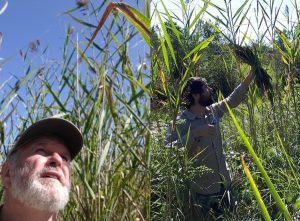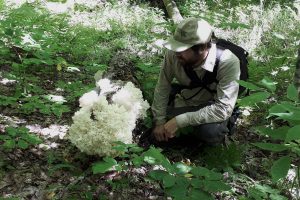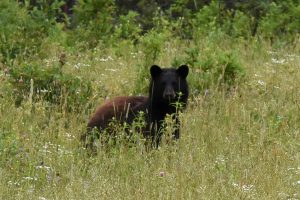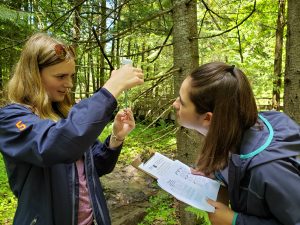During a recent Salamander Monitoring visit to Church Woods with Kim Trudeau & family, they encountered two Eastern Red-backed Salamanders. This terrestrial species of salamander can live for up to 25 years and requires a damp environment to survive. This is because they need to breathe through their skin as they do not have lungs.
The boards that we have placed at various properties create the perfect habitat for Salamanders and allow our Monitoring teams to safely check the boards for without disturbing their fragile habitat or the Salamanders themselves.
Woodsley, our youngest volunteer at 18 months, was happy to help check the boards while his sister, Adeline, filled in the monitoring form. Hopefully these young conservationists are able to inspire others to care for the natural world around them as well.

Toby Rowland appears to be making a sacrificial phragmites offering to the sun gods (which apparently worked).
Dave Hawke and Toby tackled a phragmites problem at the Probst Easement in Carden on September 9th.
While the years-old project is managing to reduce phragmites density, this year’s growth hit the 12-foot mark, making it difficult to apply controls. Seed heads were cut and big stems shortened.
European Common Reed, known as Phragmites, is an invasive perennial grass that spreads quickly and out-competes native species for water and nutrients. Its roots releases toxins into the soil which hinders growth of surrounding plants. While it prefers areas of standing water, its roots can grow to extreme lengths, allowing it to survive in relatively dry areas.

While doing a preliminary biological inventory of a proposed property acquisition on Black River Road, Dave and Toby found this impressive presentation of Comb Tooth Fungus.
The property has a wonderful mix of rockland, wetland, woodland and pasture components.

Lisa and Jim Neville, our reptile monitoring team at one of our more northerly nature reserves, are always on the look-out for skinks. The Five-lined skink is Ontario’s only lizard and is listed as a species of Special Concern in Ontario. Skinks love the granite outcrops of the Canadian shield.
As you can see, they had a successful trip, and also saw a black bear cub.
Staff have been enthralled watching monarch caterpillars thriving off milkweed plants beside the office and metamorphizing into butterflies. Watch below:

On August 14, at Turnbull Ranch Nature Reserve, Dave was joined by Paul and John to spread gravel on the lane
(later joined by Mandy of the shrike monitoring team at Wildlife Preservation Canada). Magical pile of gravel… the more you shovel away the less it looks like you did anything.
Our McIsaac Wetland bat monitoring team went on an evening visit August 5th, and before they had even started the survey bats were flying circles around them.
Roland and Jacob captured this footage just before it became too dark to film.
This site has been visited twice in 2019 and already looks promising for bats. Once the bat recorder data has been analyzed this fall we’ll be able to find out what species of bat are flying around in the video.

Waterthrush Woods Nature Reserve is water access only via the Head River or Young’s Lake near Sebright.
The Head is safely navigable during a narrow window between late spring and late summer. Otherwise it’s either running too high and fast, or so low that the many fallen trees are numerous and annoying to climb over.
July 31st staff took the opportunity to make a rare visit and document plants and animals. We saw numerous turtles, a large Bryozoan, Dodder, Buttonbush, Swamp Loosestrife, Square Stem Monkeyflower, Cardinal Flower, St. John’s Wort, the Black-Shouldered Spiny-legged dragonfly, Waterlily, and Cardinal Flower at it’s peak bloom.
We got some excellent photos which you can view here
It’s called a Pilot Year for a reason… On our fifth trip out to monitor for bats this year,the equipment malfunctioned, and we weren’t able to record any bat calls. Neighbours at Church Woods say they have definitely seen bats in the area, so we will return once we repair our bat monitoring device. This is our first year of the Bat Monitoring program, and we’re working out the kinks.
Never a dull moment, however. The team of Joelle Burnie, Lindsay Cass, Meagan Coughlin, and Toby Rowland spotted two baby Barred Owls and Joelle captured one of them on film. -July 23, 2019

“It is the best of times, it is the worst of times.” Guardians of the Blueberries are fierce this year. – July 22, 2019

The Kris Starr Sanctuary straddles both sides of the Monck Road. Dave Hawke describes best how to get there: “Drive past Sebright, Quaker Oaks, keep going, and when you feel like you’ve gone too far, you’re almost there.”
The north side of the road borders QEII Wildlands Provincial Park. The Head River meanders through the south side, and on July 22nd our new water monitoring team of Jan Walinck and Joelle Burnie made their first visit.
They will be monitoring the Head River for Temperature, Turbidity, Phosphates, Nitrates, Alkalinity, pH, and Dissolved Oxygen each month. Measuring depth is more challenging than at many of our other sites, due to the width and depth of the river, which can flow wildly in the spring.
Many thanks to Tom Wilson who monitored this site for two years.
While our focus is on stewarding Conservancy Nature Reserves, we try to support others in our region working toward the same goals when we can.
The Orillia Fish & Game Conservation Club (OF&GCC) has been partnering with us for approximately four years to monitor some significant stream habitat in our region that falls outside our Nature Reserves. We provide equipment and training, and they do the monitoring.
Silver Creek is a cold water stream in Severn Township with naturally-occurring Brook Trout. It is facing threats from stormwater and fertilizers. About five years ago Ontario Streams worked with OF&GCC to create a fish ladder in Silver Creek, and now they monitor water quality there monthly.

Photo: Dorthea
The trial period for our new Bat Monitoring Program is underway, and we’ve surveyed four properties as of July 18th.
We don’t often mention McIsaac Wetland because it is an inaccessible hardwood swamp, but that doesn’t mean it’s not significant habitat. Last year it started getting more attention when we established a frog monitoring program there, and on July 17th we visited to survey for bats and discovered it’s a hotspot!
With the monitoring device we rented hoisted onto a selfie stick, Roland immediately started hearing clicks on the headphones, while Joan kept notes. The monitoring device translates the bat’s sonar into clicks that can be heard by human hearing, and also records the calls which will be identified to species later in the fall. Bats raced overhead, sometimes dropping to within a dozen feet of us, as fireflies danced in the grass and the full moon rose.
Thanks to the frog monitoring team for alerting us to the bats in the area, to the Ontario Land Trust Alliance for the equipment and training, and to everyone who donated to the Angela Rehhorn Citizen Science Fund. To see more photos from Bat Monitoring and the Summer 2019 Field Season, click here

Photo: Marilyn Clark
We’re not always sure when we establish a citizen science monitoring activity on one of our Nature Reserves if it will pan out. Sometimes our teams need to be good sports and go along with our hunches…and we’re wrong.
Our reptile monitoring team of Marilyn Clark and Mary Ellen Mulligan is a case in point. We thought we had set them up with a Nature Reserve that would be excellent for Reptile Monitoring, but their one observation was hard-won. Recently they were rewarded with this basking Midland Painted Turtle and Marilyn captured this excellent photo. Knowing that a particular habitat is low in reptile populations is just as important for us as knowing there are lots – although it’s not as much fun for the volunteer.

Photo: Dave Hawke
While checking out Sulphur Springs Ranch (Carden Alvar) for invasive plant species, Stewardship Manager Dave Hawke, and summer field staff Alycia and Adrienne had a close encounter with a resident. Once Dave got its attention, the bear looked a bit baffled as to why people were wandering around its home turf. No dog-strangling vine found, horray! – July 12, 2019
On July 9th While out scouting for a reptile monitoring route in Carden Alvar PP Lindsay Cass and Toby Rowland spotted a couple of sparrows which had been banded. They managed to get a photo of a Grasshopper Sparrow with the band E09 visible. This Sparrow had been banded on June 12th, 2019 roughly 200m from where he was spotted on July 9th. This individual was an adult male, Band Number 2091-67037, with a wing 65mm long and weighing only 18.3g.

Seven new volunteers joined the Water Monitoring Team after taking our training program June 26th. Some will be monitoring streams on our Nature Reserves, and some will be monitoring other critical streams in our region through partnerships with the Orillia Fish & Game Conservation Club and Jeff Cole’s Environment Club at Patrick Fogarty Secondary School.
Special thanks to Jane Bonsteel and Meagan Coughlin who volunteered their time to help with the day-long training program along with Dorthea Hangaard. See photos from the day and other photos from our field season here

Photo: Dorthea
Bat Monitoring: It’s all happening! Thanks to your generous donations to the Angela Rehhorn Citizen Science Fund, the pilot year of our Bat Monitoring Program has launched. On June 24th, staff from the Ontario Land Trust Alliance delivered an Acoustic Monitoring Device for recording bat calls, and taught staff how to use it.
Eleven people have already signed on to help us monitor bats on Nature Reserves, and through the month of July we will be taking them out in small groups to follow transects through five properties, hoping to record bat calls.
In September, the calls recorded will be sent to OLTA for analysis. We hope to discover which of our properties have bats, and which species are present. There are eight species of bats in Ontario, four of them listed as Endangered.
To read more about this citizen science fund, click here
June 24th: Turtles are on the move, looking for a good place to lay their eggs.

Photo: Dorthea
It’s a precarious time for turtles as they attempt to cross roadways looking for a nice patch of sand or gravel to lay their eggs. This Snapping turtle was trying to cross a busy overpass on a Monday morning, with several passers-by stopping to help. It was dangerous for both the turtle and the helpers, but luckily nobody was hurt. The turtle carried on in the direction of the Thomas C. Agnew and Fawcett Nature Reserve near Washago.
Scenes like this are playing out all over Ontario, and our summer Citizen Science Field Technician, Toby Rowland, has been transporting injured turtles from our region to the Ontario Turtle Conservation Centre in Peterborough.
If you see a turtle attempting to cross a road, remember to carry them in the direction they are travelling. Lift up the tail, slide your hand underneath the plastron, hold the tail firmly, and carry them across the road to the shoulder. Read Toby’s Article: The Perilous Life of a Nesting Turtle.

Photo: Dorthea
Sometimes it’s not so bad working on a Saturday.
On June 22nd , CC staff took Olivia and Robert Sparrow on their inaugural paddle down the Black River, to learn the basics of monitoring for reptiles along the river.
Olivia and Robert are new to the Conservancy this year, and recently moved to Toronto from Minneapolis. They were looking for a way to explore the outdoors north of Toronto, but wanted to do so with a purpose.
This winter they took two of our citizen science courses, and now they’re putting their knowledge to use along the Black River. Welcome Olivia & Robert.

It’s no secret that the Blackflies, Deerflies, and Mosquitoes are at OMG! levels this year, and some of you have been sending in photos of your bug net attire. Ann Gray worries that her husband Neil now considers their evening frog monitoring visits “date night”.

See more photos of the latest in bug net attire here

Photo: Toby Rowland
Whip-poor-will monitoring started in earnest this June around the time of the full moon, ‘though some teams were so keen to get out they started in May.
What started out as a two-year project may continue indefinitely, due to its popularity.
This year our main focus is on the backroads of Ramara and Carden township. Teams begin their surveys 1/2 hour after sunset, travelling 1 kilometre and then stopping to listen for the sound of the Whip-poor-will, travelling another kilometre, stopping to listen, and so on.
Since Whip-poor-wills lack sonar to track their prey (insects) in the dark, they are most active on a clear moonlit night.
Thanks to Environment Canada for the funding to complete this important survey work. Whip-poor-wills are listed as Threatened in Ontario.



